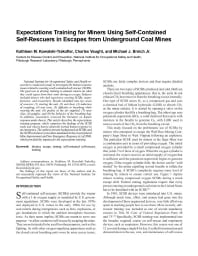Mining Publication: Expectations Training for Miners using Self-Contained Self-Rescuers in Escape from Underground Coal Mines
Original creation date: October 2008
Authors: KM Kowalski-Trakofler, C Vaught, MJ Brnich
NIOSHTIC2 Number: 20034580
J Occup Environ Hyg 2008 Oct; 5(10):671-677
National Institute for Occupational Safety and Health researchers conducted a study to investigate the human response issues related to wearing a self-contained self-rescuer (SCSR). The goal was to develop training to educate miners on what they could expect from their units during an escape. Subjects included miners who had experience wearing SCSRs, manufacturers, and researchers. Results identified nine key areas of concern: (1) starting the unit, (2) unit heat, (3) induction of coughing, (4) unit taste, (5) difficulty in breathing while wearing the unit, (6) quality of the air supplied, (7) nose clips, (8) goggles, and (9) the behavior of the breathing bag. In addition, researchers reviewed the literature on human response under duress. This article describes the expectations training program, which comprises the findings of the SCSR study and what is known about the normal human response in an emergency. The authors present background on SCSRs and the SCSR switchover procedure mandated in the recent federal Mine Improvement and New Emergency Response Act of 2006, which provided the impetus for the expectations training.

NIOSHTIC2 Number: 20034580
J Occup Environ Hyg 2008 Oct; 5(10):671-677
- The ABCs of KSAs
- Advancing Self-escape Training: A Needs Analysis Based on the National Academy of Sciences Report "Improving Self-escape from Underground Coal Mines"
- Breathing Air Supplies Research
- Cleaning, Disinfecting, and Sterilizing Self-Contained Self-Rescuer Mouthpiece Assemblies Used in Hands-On Training
- Emergency Decision-making: Underground Coal Mine Escape Scenarios - 1.0
- Probability of Making a Successful Mine Escape While Wearing a Self-Contained Self-Rescuer
- Probability of Making a Successful Mine Escape While Wearing a Self-Contained Self-Rescuer - A Computer Simulation
- Self-escape Core Competency Profile: Guidance for Improving Underground Coal Miners' Self-escape Competency
- Self-Escape from Underground Coal Mines Training Initiative
- Using Performance Management Strategies to Improve Mine Emergency Training and Preparedness